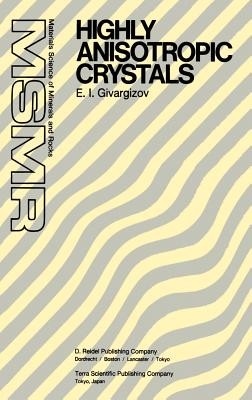
- We will send in 10–14 business days.
- Author: E I Givargizov
- Publisher: Springer
- Year: 1986
- Pages: 394
- ISBN-10: 9027721726
- ISBN-13: 9789027721723
- Format: 15.6 x 23.4 x 2.4 cm, hardcover
- Language: English
- SAVE -10% with code: EXTRA
Reviews
Description
Anisotropy, i.e., the dependence of structure and properties on direction in space, is the most striking characteristic of crystals. Anisotropy is a result of the discrete nature of the crystal lattice, and it is the characteristic which distinguishes the crystalline state from another solid state of matter, the amorphous. The anisotropy of the structure and properties of crystals (this can be called their 'internal anisotropy') is also reflected in their external structure, i.e., morphology. The reflection is, however, non-linear: properties such as mechanical hardness ... do not change strongly (typically several tens of percents, depending on direction) while the morphology ...: the linear sizes in different directions of individual crystals often differ by several multiples or even several orders of magnitude, depending on the symmetry of the crystalline lattice and/or of the crystal prehistory. The enhanced anisotropy of morphology is, as a rule, a result of growth kinetics of different crystalline faces; it reflects a non-linear character of the kinetic laws of growth. This book is devoted to high morphological anisotropy. No strict classification of highly-anisotropic crystals exists. However some typical forms, or habits, can be singled out: first, whiskers (or needles, or fibers) as quasi-one-dimensional crystals, and second, platelets as quasi-two-dimensional crystals.
EXTRA 10 % discount with code: EXTRA
The promotion ends in 11d.01:40:03
The discount code is valid when purchasing from 10 €. Discounts do not stack.
- Author: E I Givargizov
- Publisher: Springer
- Year: 1986
- Pages: 394
- ISBN-10: 9027721726
- ISBN-13: 9789027721723
- Format: 15.6 x 23.4 x 2.4 cm, hardcover
- Language: English English
Anisotropy, i.e., the dependence of structure and properties on direction in space, is the most striking characteristic of crystals. Anisotropy is a result of the discrete nature of the crystal lattice, and it is the characteristic which distinguishes the crystalline state from another solid state of matter, the amorphous. The anisotropy of the structure and properties of crystals (this can be called their 'internal anisotropy') is also reflected in their external structure, i.e., morphology. The reflection is, however, non-linear: properties such as mechanical hardness ... do not change strongly (typically several tens of percents, depending on direction) while the morphology ...: the linear sizes in different directions of individual crystals often differ by several multiples or even several orders of magnitude, depending on the symmetry of the crystalline lattice and/or of the crystal prehistory. The enhanced anisotropy of morphology is, as a rule, a result of growth kinetics of different crystalline faces; it reflects a non-linear character of the kinetic laws of growth. This book is devoted to high morphological anisotropy. No strict classification of highly-anisotropic crystals exists. However some typical forms, or habits, can be singled out: first, whiskers (or needles, or fibers) as quasi-one-dimensional crystals, and second, platelets as quasi-two-dimensional crystals.


Reviews